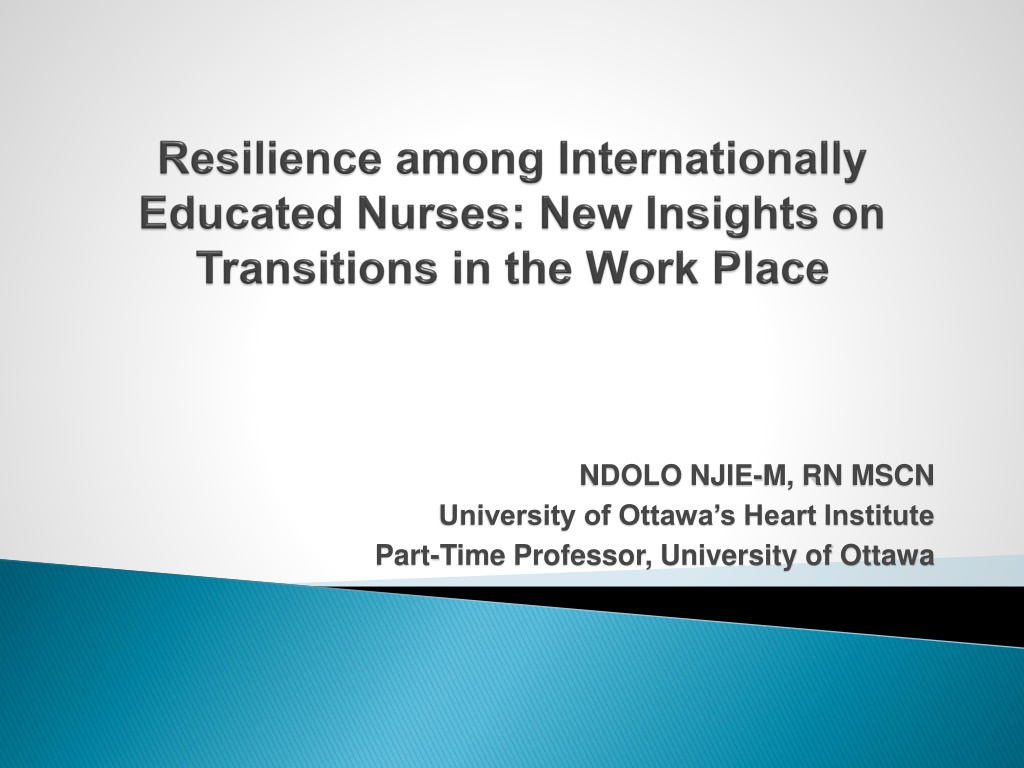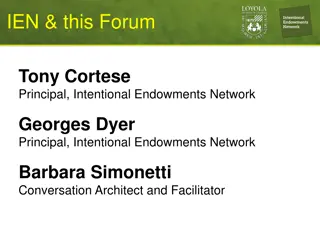
Navigating Challenges in Nursing Workforce Transition
Explore the complexities of nursing workforce transition, including shortages, workplace challenges, search strategies, and major themes such as communication barriers and cultural influences. Discover the development of insights to support the integration of internationally educated nurses (IENs) and enhance their skill acquisition in the face of workplace adversity.
Download Presentation

Please find below an Image/Link to download the presentation.
The content on the website is provided AS IS for your information and personal use only. It may not be sold, licensed, or shared on other websites without obtaining consent from the author. Download presentation by click this link. If you encounter any issues during the download, it is possible that the publisher has removed the file from their server.
E N D
Presentation Transcript
NDOLO NJIE-M, RN MSCN University of Ottawa s Heart Institute Part-Time Professor, University of Ottawa
Background Significance Purpose and Objective Literature Review Research Methodology Rigor Research Findings Discussions and Implications Conclusion
Nursing shortages in the workforce Increased international recruitment (developed/underdeveloped) Aging nurse population Early retirement Fewer graduating nurses Sources: Canadian Institute for Health Information, 2010; Health Canada, 2004; O Brien- Pallas et al., 2003)
Work place challenges during transition: Frustration Adapting to the workforce; understanding the ways of nursing in Canada Accent, language barriers
Search Strategy: CINAHL, PUBMED, ERIC (2000-2011) Grey Literature: Nursing Associations Reports University Research Centers
Three Major Themes: Language and Communication Barriers Cultural Influences and Role Expectations / Licensing Pass Rates Marginalization
Development of new insights that describe IEN transition experience Create support programs that will promote the overall integration of IENs Enhance skill acquisition and reduce vulnerability to workplace adversity
Transition: An internal process individuals go through, and come to terms with, related to a new situation brought about by change (Bridges, 2003) Resilience: An active process involving an individual s ability to adjust to adversity, maintain equilibrium, retain some sense of control over their environment, and continue to move on in a positive manner (Jackson, Firtko & Edenborough, 2007)
Presents the findings of a recent study that examined the transition experiences of internationally educated nurses in one region of Canada, centering on the recurring theme of resilience as a resource to facilitate transition into the workplace
Describe the meaning IENs ascribed to professional relationships with their nursing colleagues and other disciplinary teams during transition into their places of work
University of Ottawa REB Qualitative study Descriptive Phenomenology (Wojnar & Swanson, 2007)
Ottawa; second largest city with a higher than average immigrant population within the province of Ontario (Statistics Canada, 2009) Access Homogenous participant group (similar provincial licensing legislation)
Initiated through purposive sampling and facilitated through snowball sampling techniques RNs only in Ontario to maintain a common scope of practice Local nursing networks Eleven IENs were final participants.
Strategies: In-depth semi-structured interview (transcribed verbatim) Notes from follow-up discussions during data analysis and validation Personal research journal (audit trail)
RN Group: Uniformity in licensure and scope of practice Maximum variation: ethnicity, age, place of nursing education, type and location of current nursing practice Data Saturation: following interviewing eleven participants
Bracketing Data Analysis involved: 1. Recurrently reading and listening to participant narratives 2. Highlighting sections of the transcripts 3. Proposing ideas about its meaning 4. Clarifying and validating the proposed meanings with IENs. 5. Organizing meanings into groups of themes. Quality Audits: reading each transcript while simultaneously listening to audiotapes.
Eligibility criteria: Minimum of one year and maximum of five years post- RN licensure Obtained their nursing education outside of Canada Profile: Females Landed immigrant status All but one was married Aged from 25 to 47 years old (average age 34)
6 Asia 5 4 NUMBER OF IENs Eastern Europe 3 2 USA Carribean Africa 1 0
INTENSIVE CARE UNIT (1) OPERATING ROOM (2) MED-SRG(3) MENTAL HEALTH (2) COMMUNITY (1) CRITICAL CARE (2)
RELATIONSHIP WITH COLLEAGUES The majority of IENs felt their colleagues questioned their knowledge and competence Overall, these attitudes either facilitated or hindered their work relationship in a positive or negative way Four sub-themes (teamwork, acceptance by staff, incivility, and proving one s self).
I depend on others personalities, some nurses become irritated if you ask questions while some are helpful. Some nurses are not very helpful and this hinders question asking. This is a problem especially on this unit where patients are unpredictable due to their mental status .
If a nurse is busy, it hinders the quality of care patients receive; there is no this is my load and that is yours, as it is here in Canada. If a patient needs something I take care of it. Nursing care is ongoing, if you are done, you help others willingly.
In Canada, there is no division between experienced nurses versus non-experienced nurses. There is no hierarchy, we all work together, there are OR aides here. Back home the nurses do all the jobs. Nurses have it easy here, but they still complain.
I am a new nurse on the floor, you learn a lot from mistakes and from the mentorship of more experienced nurses and their clinical judgment, my colleagues are receptive, and I feel I am not left alone.
Operating room nursing is not direct patient care like on the floors, you deal with colleagues, not patient care. Some words are hard to pronounce, I have a hard time spelling some drugs. The nurses are good and friendly here, they help me.
Make the environment conducive teach the nurses how to work with other people, it s not easy coming to work in another country. They need to put themselves in other people s shoes
Sometimes they [some surgeons] are mean to me they ask are you Canadian? I think the hospitals should hire Canadians first. I need to learn to speak up.
Some surgeons or anesthetists if they don t like you, they treat you badly they don t talk to you, and this hinders communication.
I dont understand why nurses bully [their colleagues]. We need to be more patient and adjustable, I don t take the bullying personally; I am more tolerant it s due to differences in situations, i.e., us coming to work here.
Everyone has their territorial thing, before they[the Canadian trained nurses] thought I didn t know what to do because I came from another country. I had to prove myself when you shouldn t because the college has assessed everything. Once they see that you know what you are doing, they ll come around after you prove yourself.
You have some staff who are difficult to work with and who gossip, especially about IENs; I just work hard to show them that I am capable. Nurses are harder on IENs because they feel they don t have the same educational background as them, we wrote the same nursing exams.
Canadian-trained nurses have some difficulty accepting us; sometimes people underestimate us by their attitudes. Maybe because of their mental status or it s just their personality we are less expressive culturally, most here are expecting more in terms of expression; knowingly or unknowingly we are learning to adapt (But) their attitudes change once they see your experience and knowledge .
This study revealed an underlying theme of resilience as an important coping mechanism. Resilience was manifested over time in the IENs unrelenting attempts to prove their capability to provide care to patients in a Canadian context
Demonstrates an inner strength and unwavering ability to perform well at their nursing duties in order to establish credibility among their nursing colleagues.
Needing time to adapt Need for Canadian-educated nurses to understand different cultural behaviors unique to IENs New insights on IENs personal resilience during their transition as RNs
Its contribution has broadened the description of IEN transition in different clinical settings Highlights the value of IENs personal resilience in lowering their vulnerability levels to adversity at the workplace
Clinical Create formal discussion forums Education Use different cultural behaviors as clinical learning examples incorporated into undergraduate nursing education
Administration Need for increased need for time to adapt into their new work environment during their transition period Research Exploring the concept of personal resilience to create a comprehensive support mechanism during transition for more decisive conclusions
Requires more than successfully obtaining their provincial licenses Inclusive work environments Developing innovative ways of leveraging and nurturing resilience among IENs during transition is vital and requires the involvement of all stakeholders
Canadian Institute for Health Information (CIHI) (2010). Regulated Nurses: Canadian Trends, 2006 to 2010. [Online] Available at https://secure.cihi.ca/free_products/RegulatedNursesCanadianTrends2006- 2010_EN.pdf Bridges, W. (2003). Managing transitions: Making the most out of change. Cambridge: Perseus books. Health Canada. (2004). Health human resources: Balancing supply and demand. Health policy research bulletin. [Online] Database 8. Available from http://www.hc-sc.gc.ca/sr-sr/pubs/hpr-rpms/bull/2004-8-hhr- rhs/index-eng.php. Jackson, D., Firtko, A., and Edenborough, M. (2007). Personal resilience as a strategy for surviving and thriving in the face of workplace adversity: a literature review. Journal of Advanced Nursing, 60 (1): 1 - 9. O Brien-Pallas, L., Alksnis, C., Wang, S., Birch, S., Tomblin Murphy, G., Roy, F.A., & Sajan, P. (2003) Early retirement among RNs: Estimating the Size of the Problem in Canada. Hospital Quarterly, 7 (1): 1 8. Statistics Canada. (2009). Table 4 Summary table of peer groups and principal characteristics. Archived 2012-12-13. Retrieved from http://www.statcan.gc.ca/pub/82-221-x/2012001/regions/hrt4-eng.htm Wojnar, D., & Swanson, K. (2007). Phenomenology: An exploration. Journal of Holistic Nursing, 25, 172 182.


















